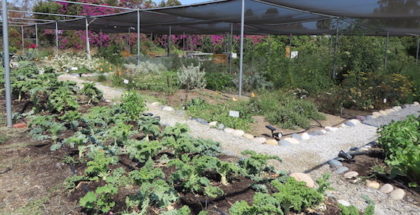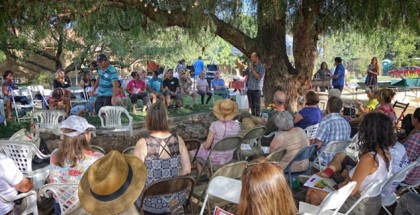It’s Almost Summer in the Urban Garden: Tips for Planting Hot Weather Crops
May 11, 2016 | Khristopher Flack

Zucchini. Source: Wikipedia.
It’s almost summer, and for many that means it’s time to plant the vegetable garden.
Of course, you may have put many of your plants in the ground already, but for those who like to put their vegetable garden in all at once, mid-May is often the time to do it.
The changing climate has complicated this somewhat, so gardeners in northern areas may need to wait until June to put in hot-season crops. This is particularly the case in cities where the city center may experience a several degree differential from surrounding areas. due to an urban heat island effect Check your local USDA zone map to see where you are..
Most summer crops discussed will not tolerate a frost, let alone a freeze, although a blanket on a cold night or row cover will provide a few degrees of protection.
It might also be worth revisiting the age-old practice of planting by various botanical indicators. Eleanor Perenyi writes that it was once common practice to plant corn when oak leaves were the size of squirrel’s ear. This phenology will involve some knowledge of squirrels as well as oaks, but it may prove to be as reliable as more sophisticated predictions.
General Recommendations for All Zones
- Use shady areas of the garden for plantings of lettuce and brassica salad mix. They will often taste better if grown in partial sunlight during the hottest months.
- Wait until soil has warmed up to plant corn seeds. They will only germinate if the soil temperature is above 50 degrees. Beans also need warmer soil temperatures to germinate.
- Keep on top of watering by making sure that plants receive at least an inch of water a week in cool weather and more in hot weather. This is especially important for recently seeded and transplanted crops. Direct-seeded crops need to be kept constantly moist and transplants should be watered at least once a day for the first week.
- Try to weed every week with a stirrup hoe, collinear hoe or other long handled tool. The periodic disturbance of urban soils can also help with water infiltration in urban soils that are prone to crusting.
Recommendations for Northern Gardeners (Zones 3-7)
- Pay close attention to your area’s frost-free date, when there is zero statistical chance of a frost. You can either wait until after this date has passed to plant or live on the edge and plant a little bit ahead of it while taking care to check the weather and put out frost protection if needed.
- Plant potatoes in the week or two before the last frost. The tops of the plants may die in cold temperatures, but the plants will otherwise be unharmed. Consider using a heavy layer of straw mulch to help tuber formation, decrease watering needs and control weeds.
- Transplants will do better in cool spring soil than seeds. Put out tomatoes, peppers and eggplant starts as soon as it is safe to do so, burying tomatoes as deep as possible because they will root along their stems. It’s a good idea to water transplants in with a liquid fish and kelp fertilizer to help them get started.
- Cucumbers and squash also do better in warmer soils. Consider starting them as two-week transplants in a sterile soil mix like Sunshine Natural and Organic. Although they grow well as a direct seeded crop, transplanting can help them out-compete the cucumber beetles that often kill young plants.
- Weigh space demands of corn, summer and winter squash, watermelons and sweet potatoes, against their production in northern gardens. Some of these like watermelons and sweet potatoes are marginal here. All of them are space intensive and might take up too much ground in a small city garden.
Recommendations for Southern Gardeners (Zones 8-10)
- Harvest cool season crops to make room for hot season crops.
- Put in any plantings of summer crops that you haven’t already planted.
- Fertilize plants that seem to be growing slowly with an organic fertilizer or by top-dressing with compost now. Doing this later may encourage vegetative growth to the detriment of fruit production.
- Monitor for insects, trying hand removal first and then pest-specific organic pesticides as they emerge.
This post originally appeared on Seedstock.com: http://seedstock.com/2016/05/08/its-almost-summer-in-the-urban-garden-tips-for-planting-hot-weather-crops/













Submit a Comment